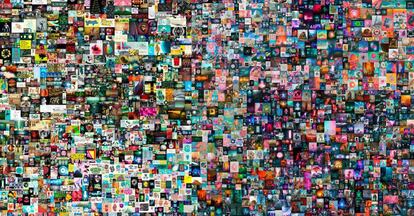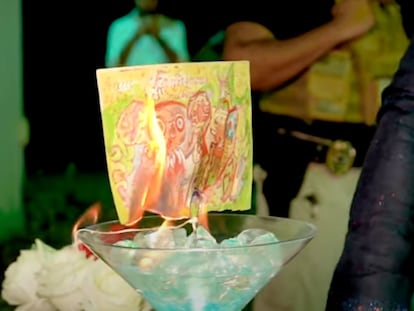Will the NFT phenomenon be nipped in the bud?
NFTs started the year with a record volume of transactions, now it looks as though they could lose almost 98% of their value – a temporary crisis or the punchline to a bad joke?

Two recent news items confirm the extreme volatility of the digital non-fungible token (NFT), which has been at the center of a speculative storm in the art world. On September 27, Martín Mobarak, a private collector from Miami, burned Fantasmones Siniestros (Sinister Ghosts), an original work by the Mexican artist Frida Kahlo, after digitizing it and launching 10,000 NFTs that will go on sale soon. According to Mobarak’s calculations, with the physical drawing no longer in existence, the digitized versions will soar in value.
Coinciding with Mobarak’s stunt, Christie’s auction house has just launched its 3.0 auction platform, focused exclusively on NFTs, and has kicked off by putting nine works by the 18-year-old activist and visual creator Diana Sinclair under the hammer. Sinclair is wryly defined as the Lionel Messi of contemporary digital art. That is to say, no matter how spectacular the collapse of the business model, there is no lack of unscrupulous entrepreneurs willing to keep it afloat.
According to Noah Davis, the crypto connoisseur that Christie’s consulted before embarking on its foray into the NFT market, the volatility of recent months is simply due to “the fact that we are still in the embryonic phase of a new artistic tradition, something like the cave painting period, and there are still no stable criteria that allow us to separate the wheat from the chaff.” This guru of disruptive digital art believes that NFTs will soon reach their definitive consolidation phase.
To better understand the ups and downs of this market, ask yourself one question: how much is the NFT of Twitter founder Jack Dorsey’s first tweet worth today? The question is to some extent rhetorical, because its current owner, investor Hakan Estavi, who bought it for the equivalent of $2.9 million in March 2021, is putting its re-sale on hold until the market for crypto assets emerges from the doldrums. But we do have an idea of what value potential buyers ascribe to it right now: $280.

Last April, Estavi put his brand-new original of Dorsey’s Twitter NFT up for auction. He intended to sell it for 14,969 ethers – the equivalent in a major cryptocurrency to $50 million, promising to give half that sum to charity. But it turned out his digital asset had lost more than 99% of its value. Far from $50 million, in today’s market it is worth the price of dinner for two at Zuni Café, one of the San Francisco restaurants Dorsey frequents. It makes perfect sense that a platter of oysters would be worth more than a terse text by Dorsey – “just setting up my twttr” – typed back in 2006. What makes it exceptional is that it is an NFT that represents a piece of internet history and a virtual asset with an associated certification of authenticity and proof of ownership generated using the same blockchain technology used by cryptocurrencies.
That would somehow guarantee that in a world of virtual objects that can be reproduced ad infinitum, the NFT would be the original of Dorsey’s tweet, in the same way that La Gioconda – valued at $960 million - is the one painted by Leonardo da Vinci and kept in the Louvre Museum, rather than a forgery. Of course, the difference is that La Gioconda is a masterpiece of analog art, the fruit of the efforts of an individual we have considered a genius for five centuries. According to NFT digital asset investor and collector Mitch Lacsamana, the supposed original of that first tweet would only be worth “something” if “Dorsey was willing to take his buyer on a sightseeing tour of Silicon Valley,” including perhaps dinner for two at Zuni Café.
However, Lacsamana does not think it so ridiculous that someone might shell out $69 million for the NFT of Every Day: The First 5,000 Days, a work by the American artist Mike Winkelmann, better known as Beeple, at an auction at Christie’s in 2021. A simple click would be enough for you to use it as your desktop backdrop. Its current owner has a certified and exclusive link to the original, which is kept in an image bank. And he has paid a fortune for that link.
But perhaps the anecdote that best illustrates the ambivalence of the NFT market is one that emerged from the NBC television network’s studios last January. Host Jimmy Fallon wanted to give a practical demonstration of how up to date he is on digital assets and showed off his latest acquisition on air: the NFT of a Bored Ape, which had cost him a few hundred dollars. It took only a few seconds of the image’s exposure for viewers to identify the address of Fallon’s digital asset portfolio. Screenshots began to appear on Twitter detailing the cryptocurrency transactions the presenter had made.
Having a portfolio of digital assets is equivalent to opening a Swiss bank account that permits any other client access to your financial information. There is no privacy with regard to transactions. Theoretically, anonymity is guaranteed, because to open a crypto asset portfolio you do not need to provide a real name or a physical address. However, a slight indiscretion is enough for your anonymity to be blown. When your assets increase in value exponentially, these inconveniences are of no concern. But when the bubble bursts, those who invested millions in digital assets that then trade at rock-bottom prices must be wondering what the hell they got themselves into.
Tu suscripción se está usando en otro dispositivo
¿Quieres añadir otro usuario a tu suscripción?
Si continúas leyendo en este dispositivo, no se podrá leer en el otro.
FlechaTu suscripción se está usando en otro dispositivo y solo puedes acceder a EL PAÍS desde un dispositivo a la vez.
Si quieres compartir tu cuenta, cambia tu suscripción a la modalidad Premium, así podrás añadir otro usuario. Cada uno accederá con su propia cuenta de email, lo que os permitirá personalizar vuestra experiencia en EL PAÍS.
¿Tienes una suscripción de empresa? Accede aquí para contratar más cuentas.
En el caso de no saber quién está usando tu cuenta, te recomendamos cambiar tu contraseña aquí.
Si decides continuar compartiendo tu cuenta, este mensaje se mostrará en tu dispositivo y en el de la otra persona que está usando tu cuenta de forma indefinida, afectando a tu experiencia de lectura. Puedes consultar aquí los términos y condiciones de la suscripción digital.
More information
Últimas noticias
How Japan is trying to avert ‘digital defeat’
From digital curfews to blocking apps: How technology experts protect their children online
Why the price of coffee has skyrocketed: from Brazilian plantations to specialty coffee houses
Confined to a Cuban hospital: When electricity is a matter of life or death
Most viewed
- Pablo Escobar’s hippos: A serious environmental problem, 40 years on
- Reinhard Genzel, Nobel laureate in physics: ‘One-minute videos will never give you the truth’
- Why we lost the habit of sleeping in two segments and how that changed our sense of time
- Charles Dubouloz, mountaineering star, retires at 36 with a farewell tour inspired by Walter Bonatti
- The Florida Keys tourist paradise is besieged by immigration agents: ‘We’ve never seen anything like this’











































